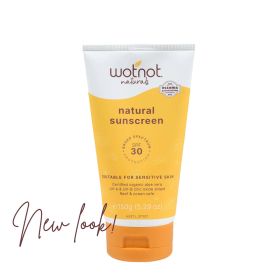2014 Natural Sunscreen Shopping Guide
Learn what sunscreen is right for your family with our 2014 natural sunscreen shopping guide. Summer is awesome & being out in the sun has great benefits for your health, both physically & mentally. I've been told by our consulting naturopath that getting 20 minutes of sun on as much of your body as you can in the middle of the day is great for vitamin D production. I've also been told by my optometrist that getting out in the sun is good for looking after your long distance eye sight (who knew THAT one!).
We'll never play that 'fear' game here telling people they need to cover themselves from head to toe everyday in sunscreen, but if you're out in the heat of the day for longer than 20 minutes,(10am to 2pm or 11am to 3pm in Daylight Savings) it is a good idea to protect yourself, whether it be slip, slop or slap.
If you decide to protect with natural sunscreen instead of a chemical based sunscreen, there's a few things to bear in mind.
- Natural sunscreens (or mineral sunscreens as they're also known) are designed to sit on TOP of your skin as a barrier. The active ingredient is usually zinc oxide, the white stuff we used to put on our nose as kids. Chemical based sunscreens are absorbed by your skin and absorb the suns rays. They need to be applied more frequently and some research suggested they contain endocrine disruptors (like BPA in drink bottles).
- Natural sunscreens are usually greasier than their chemical counterparts that absorb in to the skin. It's just something you need to learn to live with. They're not designed to rub in, and zinc oxide is drying. They need an oily base to hold the zinc.
- As an ingredient comparison for active ingredients, those we sell have ONE active ingredient of zinc oxide (which is micronised to reduce the white pasty look on your skin) while a typical chemical based sunscreen has the following active ingredients (this list is from the Cancer Council's product):-
Active Ingredients: Butyl Methoxydibenzoylmethane 50 mg/g, 4-Methylbenzylidene Camphor 40 mg/g, Octocrylene 20 mg/g, Bemotrizinol 10 mg/g. Preservatives: Phenoxyethanol, Hydroxybenzoates
2014 Natural Sunscreen Comparison - Eco Sunscreen vs Wotnot vs the new Little Innoscents vs Invisible Zinc
Today, I chose 4 zinc oxide based sunscreens to test for our 2014 natural sunscreen comparison. The first three brands we sell in store, the last one we used to, but don't anymore. It's not that I don't like the product, quite the contrary. It's available everywhere now, even the supermarket, so there's no viable way we can keep it on the shelves. We have chosen a series of criteria to compare. It's up to you to decide which is more important for you.
Ease of application
WINNER - Little Innoscents
All four products are really close here, however, the winner is Little Innoscents. It spreads really well on the skin. I think the Wotnot slightly edges out the Eco Sunscreen, but we're honestly splitting hairs here. Don't use this as a reason to pick one of over the other.
All of them can separate in the heat and should be mixed / squeezed in the tube prior to application. If you don't, you'll find some liquid run off. This is really common with organic skin care products in tubes. We see it with the Suvana lip balm too.

Is it greasy?
LOSER - Wotnot
The biggest complaint about the Wotnot sunscreen is that it's greasy. If you know me at all, you'll know that I won't blow smoke up your behind to sell you something. Honesty & integrity are pretty big around here. The Wotnot IS greasy, and if you have a big issue with that, rule this one out right now. Some customers report that it can stain clothes. I personally didn't find it, but also didn't do much to test it either. I, however, really like the fact that it's greasy, and you'll find out why if you keep reading.
Do I look pale & pasty after application?
WINNER - Wotnot, closely followed by Little Innoscents
With the Invisible Zinc, absolutely yes. Big time. The Eco Sunscreen leaves you a little pasty, the Little Innoscents, barely, the Wotnot does not. If you don't want to look like Casper the friendly ghost, then you need to put up with looking a little 'shiny' and go with the Wotnot.
Does it protect me from sunburn?
WINNER - 4 way tie
The big thing I wanted to know here, apart from the obvious 'does it work', is whether SPF50+ is any better than SPF30+. Despite the numbers, SPF50+ is never meant to be 40% better than SPF30+. The difference is marginal. Today I put Eco Sunscreen on my left arm, Invisible Zinc on my right arm and spent a couple of hours out in the sun and in the water. I did not burn on either arm and I cannot tell the difference in colour between the two. Results may vary if you stay out all day, but seriously, sunscreen or not, don't stay out all day. Sunscreen can only do so much. Even with the best protection, you're going to burn if you stay out for long enough. All four products were a tie for me.
How does your skin feel at the end of the day?
WINNER - Wotnot
Remember that shiny greasy thing you had going at the start of the day with the Wotnot. Evening you is going to LOVE you for choosing it. Wotnot ended up on my face and my front torso and legs, while the other two did my arms & my back. My torso and legs feel a lot nicer. My arms feel a little dry, even after using coconut oil in the shower. I'll be lathering up with a good quality body moisturiser before heading off to bed.
How easy is it to wash off?
WINNER - Wotnot
LOSER - Invisible Zinc
In our 2014 natural sunscreen comparison, this isn't an obvious question to ask or thing to consider, but at the end of the day, it really is. Put simply, Invisible Zinc is really hard to get off. A bit of liquid soap lather isn't enough. I still see little white lines in the creases of my skin. The only way to get it off is with a bit of scrubbing. For me, I grab my Eco Tan exfoliating mitt and the Olive Oil Skin Care Company liquid soap (which is totally 100% pure & natural as it has 1 ingredient, saponified olive oil) and get a really good lather up. After that, I wash out the mitt and then put a dollop of coconut oil on to the mitt and go over again, adding a bit of moisture back in to the skin. This is a nice thing to do regardless, but it's absolutely necessary with the Invisible Zinc.
Cost
WINNER - Wotnot
In our 2014 natural sunscreen comparison, compared to budget chemical sunscreens, they're all in the higher price range, but the Wotnot is the winner. I do find that you need to use a little more Wotnot than the Eco Sunscreen, so this probably puts them on a pretty even playing field. The Invisible Zinc only comes in the 50ml, making it the dearest.







